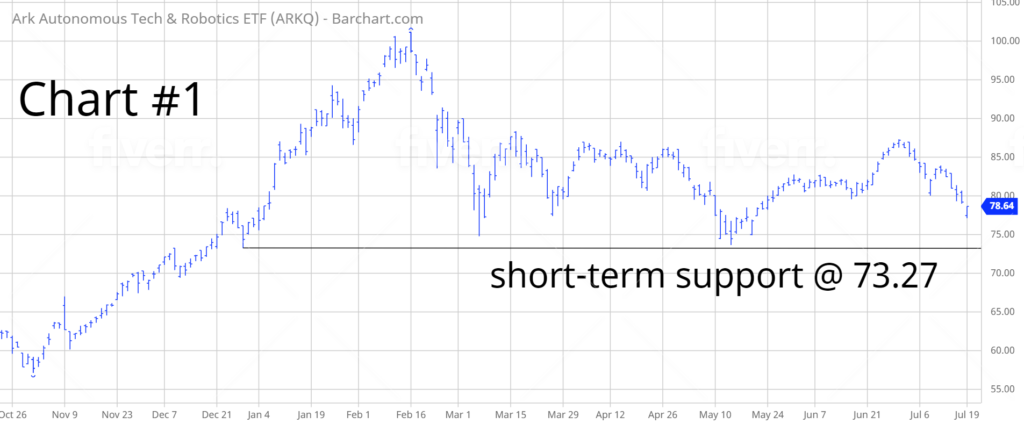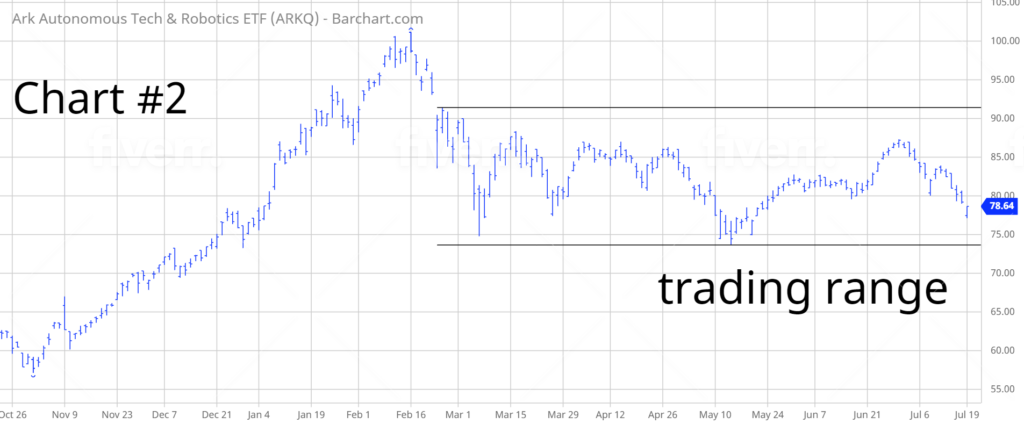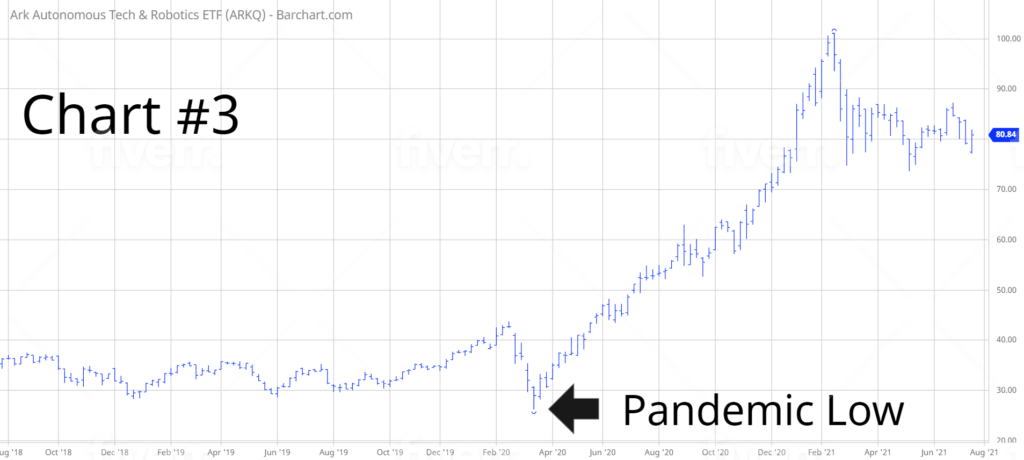
ARK Autonomous Technology & Robotics EFT (ARKQ)
Key Statistics
Minor Support Level 73.27 Minor Resistance Level 93.05
Major Support Level 26.19 Major Resistance Level 112.18
Minor Buy Signal 98.22 Minor Sell Signal 69.42
Major Buy Signal 119.01 Major Sell Signal 17.97
BRIEF OVERVIEW – ARKQ
Over the course of the past two decades, society has witnessed an enormous amount of changes in the way people conduct their daily lives. Technological advances have completely altered the way consumers communicate, work, travel, shop, eat and educate themselves. There have been major disruptions in various industries across the global landscape. Most likely, this is just the tip of the iceberg. This trend will continue for the next 20 to 30 years.
One industry that is in the early phases of causing massive disruption is the autonomous vehicle industry, more commonly known as self-driving cars. This relatively new industry has the potential to alter large swaths of the US economy.
Although self-driving cars have been in existence for several decades, the technology simply wasn’t available to cause any type of large scale advancement. During the past decade, the industry has seen tremendous progress. However, we are still in the infancy stage. Therefore,
the true economic impact of self-driving cars simply cannot be calculated. Nobody knows with any degree of accuracy how this industry will unfold during the next few decades. All we can do is form an educated guess based on the information currently available. However, it’s probably safe to assume that most of today’s forecasts and projections concerning self-driving cars will be wrong.
Let’s review a few industries most likely to be impacted by self-driving cars. In addition to various industries, the overall economy will be affected as the labor force itself will most likely be disrupted. Let’s examine the details.
Automobile Industry
The most obvious industry to be impacted by self-driving cars is the automobile industry. Based on data provided by the Bureau of Labor Statistics in May 2021, 7.02 million people are employed in this industry. This number includes auto dealers, repair and maintenance, tire shops, auto parts and manufacturers. According to Statista, 14.5 million passenger cars and light trucks were sold in 2020. Overall, the auto industry accounts for 3.5% of US gross domestic product (GDP). Obviously, this industry is critically important to our nation’s economy.
How will self-driving cars affect the US automobile industry? Currently, there are two schools of thought concerning the impact of self-driving cars on the auto industry. The Federal Highway Administration recently reported that Americans drove 2.83 trillion miles in 2020. Many experts contend this number will increase as the industry slowly transitions to autonomous vehicles. Based on their research, the increase in vehicle miles traveled (VMT) will be pushed forward by children, people with disabilities and the elderly. This will increase the demand for vehicles as more miles are traveled.
These same experts also believe that shared autonomous vehicles will increase VMT as consumers will have on-demand access to vehicles 24 hours per day. For instance, vehicles will not sit in a parking garage 8 hours per day. Instead, these vehicles will constantly be used for short trips and daily activities. Consequently, as VMT increases, the vehicles will have to be replaced much sooner, thus auto sales will actually increase.
Other experts completely disagree with the VMT theory. Instead, they argue that an influx of self-driving cars will trigger a dramatic growth in ride-sharing services like Uber and Lyft. Consequently, new car sales will plummet over the course of the next decade. The lower cost of ride-sharing compared to car ownership will drive the decline in new car sales. If this analysis is correct, fleets of autonomous vehicles owned by companies like Uber, Lyft and Tesla will comprise the majority of cars on the road by the early-2030s.
Which theory is correct? Will an increase in VMT propel the automobile industry forward or will autonomous ride-sharing services dramatically reduce the overall demand for vehicles? Most likely, we won’t discover the true answer for at least another ten years.
Trucking & Freight Industry
Most industry experts agree the trucking and ground-shipping industry will experience a significant boost from the development of autonomous vehicles. Fully automated vehicles will allow convoying, in which the lead driver of a multiple chain of trucks is in control of the driving. The other trucks in the convoy would require no human input and are connected wirelessly to the lead truck. Convoy systems could substantially increase the efficiency rate of the entire industry by allowing long distance drives with large quantities of goods. Additionally, trucking companies would save fuel, time and money with autonomous vehicles. McKinsey & Company, a management consulting firm, estimates that the trucking industry could potentially save $100 to $500 billion per year by 2025 through the integration of driverless vehicles.
Of course, truck drivers are concerned about the loss of employment due to automated vehicles. Based on data provided by the American Trucking Association, there are approximately 3.6 million professional truck drivers in the US. How many of these jobs will be lost? According to industry experts, all driving jobs will eventually disappear as automated trucks slowly replace the current fleet of trucks on the highway. Of course, this process will take many years to come to fruition. However, it’s not all bad news for the American trucker. Many drivers will play more of a technical role, as they monitor the driverless system. Most likely, wages will increase as drivers segue from truck driving to onboard computer operators. However, all industry experts agree that the trucking industry will experience a large reduction of jobs.
Auto Repair & Auto Parts Industry
According to McKinsey & Company, 90% of all traffic accidents are the result of human error.
Self-driving cars will virtually eliminate traffic accidents. As a result, collision repair shops will lose a huge portion of their business. Additionally, the demand for new car parts will decrease because of fewer crashes. This will certainly disrupt the business model of steel producers and parts manufacturers.
On the positive side, a few auto shops could find new business opportunities in aftermarket personalization of vehicles by customizing the more important interior of automated vehicles. However, these job opportunities will be rather limited.
In terms of auto maintenance, this portion of the overall auto industry could remain intact as self-driving cars will be on the road 12 to 14 hours per day. Consequently, there will be an increased demand for vehicle maintenance.
In regard to industry disruption, self-driving cars will clearly have a negative impact on the auto parts and auto repair industry. For those entrepreneurs looking to start a new business, this would definitely be an industry to avoid.
Medical Industry
The improved safety features of self-driving cars will certainly have a negative impact on the medical industry. According to the Center for Disease Control (CDC), motor vehicle crashes are one of the leading causes of death in the United States. Approximately 100 people die each day from vehicle related accidents. In 2018, the emergency department visit rate for motor vehicle crashes was 10.5 visits per 1,000 persons.
Clearly, autonomous vehicles will change the overall landscape of the entire industry. Fewer accidents means less demand for doctors, medical personnel, emergency responders, hospital staff, medical supply providers and medical insurance employees. Other industries indirectly connected to the medical industry will also experience a reduction in demand for their goods and services.
According to the National Highway Traffic Safety Administration (NHTSA), motor vehicle accidents accounted for $23 billion in medical expenses in 2016. If self-driving cars reduce traffic accidents by 50%, the medical industry would experience an annual reduction in its revenue stream of $11.5 billion. These numbers are absolutely staggering, as self-driving cars have a ripple effect across a large number of industries associated with the medical industry.
Legal Industry
Approximately 76,000 attorneys in the United States specialize in personal injury, which represents about 6% of all practicing attorneys. Vehicle collisions are the most common type of tort case, accounting for approximately 35% of all civil trials. As autonomous vehicles reduce the number of accidents, there will be less need for personal injury attorneys. A secondary effect will be a decrease in demand for law schools. Most likely, the legal profession will look much different in 20 years versus today.
Entertainment Industry
Most likely, the entertainment industry will actually benefit from automated vehicles. More specifically, this would refer to the way people entertain themselves as they enjoy hands-free driving. The big winners will be companies that provide digital media such as Netflix, YouTube,
Hulu, Amazon and other providers of on-demand video content. Self-driving cars will allow people to experience a tremendous increase in leisurely activities as they travel. Of course, for every winner there must be a loser. Companies involved in radio and recorded music could suffer a sharp decline in consumer demand.
These are just a few of the industries that will be impacted by self-driving cars. Most likely, the majority of all industries will be affected by this revolutionary change in transportation. Let’s examine other examples of how self-driving cars will change our society.
Land Development
At first glance, it seems rather unlikely that autonomous vehicles will impact land development. However, this new mode of transportation will probably change people’s decision making process in terms of where to live.
During the past few decades, there has been a noticeable increase in people choosing to live outside of the city. This is known as urban living. Typically, land values outside of the city are less expensive. Therefore, many people would choose to build a less expensive house several miles away from their jobs in the city and simply drive to work. Of course, the downside to urban living is the expense and wasted time of transportation.
Self-driving cars could change the entire underlying concept of urban living. There are two main persuasions concerning the future trend of urban living. Some experts predict that urban living will actually increase as self-driving cars become more prevalent. Their theory is based on the belief that self-driving cars will decrease transportation costs. Consequently, more people will choose to live outside of the city in urban areas. Additionally, the aggravation of driving will disappear, thereby increasing the attractiveness of residing outside of the city.
Other experts disagree with this theory. They believe that autonomous vehicles will encourage people to live closer to their jobs in the city. The savings that people accumulate from a reduction in transportation costs will be used to pay for more expensive houses in a metropolitan area. Therefore, people will sell their urban homes and relocate to the city. These same experts also contend that many people will sell their vehicles in exchange for autonomous ride-hailing services. This will generate additional savings which can be used to purchase a home outside of the urban sprawl.
The debate among experts between urban living and city living is a perfect example of our inability to accurately forecast the impact of self-driving cars on our nation’s economy and our lifestyle choices. At this point, it’s an educated guess, at best.
Parking Garages and Parking Spaces
If consumers choose to use autonomous ride-hailing services, the demand for parking garages and parking spaces will fall dramatically. Although it’s unknowable exactly how many parking spaces are available in the US, according to research provided by the Victoria Transport Policy Institute (VTPI), there are approximately 800 million parking spaces. If self-driving cars are the wave of the future, there will certainly be no need for 800 million parking spaces. Therefore, this land could be used for additional housing, parks and recreational areas. The potential use for these parking spaces is unlimited.
Traffic Violations
An obvious side effect of self-driving vehicles will be a large reduction in the number of traffic violations. Municipalities currently depend on revenue from traffic fines to help balance their annual budgets. Therefore, city officials will be forced to find other revenue streams. One solution might involve an increase in usage fees for roads and bridges.
A reduction in traffic violations will also decrease the need for police officers and parking wardens. Fewer police officers will reduce the payroll for cities and towns. This will help offset the reduction in revenue from traffic fines.
These examples are just a small sample size of what’s in store for our nation’s economy as
self-driving vehicles change our way of life. The debate continues concerning the true economic impact of this new technology. Will the economy expand or contract based on the implementation of autonomous vehicles? Of course, it’s impossible to accurately forecast considering the fact that self-driving cars won’t be prevalent in the US economy for another decade.
In an effort to provide investors with exposure to companies that benefit from autonomous technology, the ARK Invest family of ETFs created the ARK Autonomous Technology and Robotics ETF on 30 September 2014. The ticker symbol is ARKQ. The objective of the fund is to invest in companies that create value from the development of new products and services in autonomous technology. ARKQ currently has 46 different holdings. The top five holdings include Tesla Inc, JD.com Inc, Kratos Defense & Security, Trimble Inc and Baidu Inc.
SHORT-TERM VIEW – ARKQ
ARKQ has been trading sideways during the past five months. The range is 73.66 to 91.39. Currently, ARKQ is hovering near the lower end of the range. The short-term momentum is slightly in favor of the bears. The next level of support is 73.27. The bulls can recapture the momentum on a weekly close above 93.05.
Based on the Aroon Oscillator, ARKQ has an moderately oversold reading of -52. The Aroon Oscillator is programmed differently than most stochastic indicators. The oscillator fluctuates between -100 and +100. A reading of 0 would indicate a neutral position. Therefore, a reading of -52 with ARKQ is considered fairly oversold. Most likely, the EFT is very close to recording a short-term bottom. In fact, the bottom may have occurred on 13 May @ 73.66.
LONG-TERM VIEW – ARKQ
Investing in disruptive technologies is a relatively new concept within the mutual fund and ETF industry. Many funds have been in existence for less than five years. The prevailing strategy among the money managers within this sector is to use a “thematic investing” approach. The objective of thematic investing is to capture exposure to secular trends taking shape within an economy. These trends can occur as a result of demographic shifts, changes in government policy and/or advances in technology.
During the past few years, several thematic investing trends have converged together at the same time to offer some exciting opportunities for those investors who are willing to take a long-term approach. Based on the fact that thematic investing is a fairly new idea, there is no real-time performance data to compare this approach to other strategies. Therefore, investors must be willing to accept the added risk of not having a proven track record.
Disruptive technologies are impacting our day-to-day lives rather dramatically and are forcing industries to change the way they do business. Those companies that are at the forefront of innovation have an excellent opportunity to provide significant growth opportunities for their investors.
In terms of self-driving cars, many industry experts have attempted to form an educated guess on how this disruptive technology will impact the domestic economy. Let’s review a 2017 report released by the Transportation Research Board (TRB) in its monthly journal, Transportation Research Record. Please review the following table.
Self-Driving Cars and the US Economy
Industry Industry Size Industry Change % Change
(billions) (billions)
Auto Insurance $180 ($108) (60%)
Freight Transportation $604 $100 17%
Land Development $931 $45 5%
Automotive $570 $42 7%
Personal Transportation $86 ($27) (31%)
Electronics & Software $203 $26 13%
Auto Repair $58 ($15) (26%)
Digital Media $42 $14 33%
Oil & Gas $284 $14 5%
Medical $1,067 ($12) (1%)
Construction $169 ($8) (4%)
Traffic Police $10 ($5) (50%)
Legal Profession $277 ($3) (1%)
Source Transportation Research Board, Transportation Research Record (volume 2606)
The report researched 13 different industries. Based on its research, seven of the industries will be negatively impacted by autonomous vehicles. Not surprisingly, auto insurance and traffic police will suffer the greatest damage. Digital Media and freight transportation will receive the largest benefit. Freight transportation will gain because of a dramatic reduction in labor costs.
The data from the TRB report suggests the automobile industry will actually enjoy a 7% increase in revenue. This is based on the belief that VMT will actually increase the overall sales of vehicles. Of course, there are other experts in the industry who predict vehicle sales will fall rather sharply.
The data contained in this report is based on only one forecast. There are many other reports from think tanks and industry insiders who reach a totally different conclusion. However, it really doesn’t matter because the economic environment will be completely different in 20 years when self-driving cars have invaded our cities and highways. Therefore, today’s numbers will certainly change over time.
Certainly, this is not the first time the United States has experienced an economic disruption.
Arguably, the most significant change occurred during the Industrial Revolution (1780 – 1840). During this period of time, the entire manufacturing process changed from hand production methods to machines. The Second Industrial Revolution occurred from 1870 to 1914. More recently, the Information Age began in 1975, and is still in existence.
All of these events have one thing in common; they completely altered the way Americans worked and lived. During each of these major changes, people were fearful that jobs would be lost and the level of unemployment would skyrocket. In fact, many jobs were lost. However, these jobs were replaced with better paying employment opportunities. History has proven that people are resilient and always adapt to changing situations. Thirty years from now, when historians have a chance to reflect upon the disruption of self-driving cars, they will probably reach the conclusion that the US economy actually produced more jobs along with an increase in economic activity. It’s impossible to stop the forward progress of technology.
Self-Driving Cars Will Change Our Lives
- Fewer bicycles
- Fewer buses
- Less domestic airline travel
- America’s love for cars will disappear
- Less traffic jams
- Decrease in parking tickets
- No more wasted time searching for a parking spot
- Gas stations slowly disappear
- Fewer truck stops
- Auto mechanics fade away
- Car washes & oil changing stations decline
- Less demand for radio & music
- Driver licenses will disappear
- Traffic lights & signs will become obsolete
- Parking lots & parking spaces will be replaced
- More leisure time
- Fewer overnight hotel stays
- Less demand for drive-thru eating establishments
- Self-driving cars can be used as a mini-fitness gym
- Decline of traditional fitness gyms
- Our sleeping patterns will change
- More time with our families
- “Soccer moms” could disappear as children can be safely transported
- No more trips to the grocery store or dry cleaners (self-driving home delivery)
- Dramatic reduction of litter on the highways
- Less privacy (self-driving cars will have monitoring & tracking devices)
- Consumers will be inundated with advertisements as they travel
- Sharp reduction in stolen vehicles
- Reemergence of neighborhood bars & nightclubs (no fear of DUI)
- Increase in attendance of professional sporting events
In regard to the long-term view of ARKQ, the bulls are definitely in control of the ETF. The next level of resistance is 112.18. The bears need a weekly close below 26.19 in order to generate a bearish chart pattern. Although the ETF has only been in existence since 2014, the long-term momentum is clearly in favor of the bulls.
SHORT-TERM CHART
Please review the 9-month charts of ARKQ (Chart #1 / Chart #2). Essentially, the ETF has been trading sideways since the first week of March. The short-term chart pattern is slightly in favor of the bears. The next level of support is 73.27. The trend turns bullish on a weekly close above 93.05.
LONG-TERM CHART
Please review the attached 3-year chart of ARKQ (Chart #3). The ETF has generated a massive rally following the pandemic low in March 2020. Despite a brief price correction during the past few months, the long-term trend continues to remain decidedly bullish. It certainly appears as though ARKQ will achieve a new all-time high above 101.11 by the end of 2021. The bears can eliminate the bullish chart pattern by pushing ARKQ below 26.19 on a weekly closing basis. This type of decline is highly unlikely.




